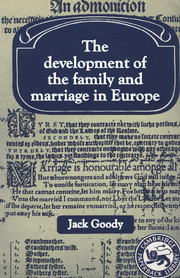Book contents
- Frontmatter
- Contents
- List of figures, maps and tables
- Preface
- 1 Perspectives
- 2 Two sides to the Mediterranean
- 3 Change in the German lands
- 4 Cousins and widows, adoptees and concubines
- 5 From sect to Church
- 6 Church, land and family in the West
- 7 Reformation and reform
- 8 The hidden economy of kinship
- 9 The spiritual and the natural
- Appendix 1 Kin groups: clans, lineages and lignages
- Appendix 2 From brideprice to dowry?
- Appendix 3 ‘Bilaterality’ and the development of English kin terminology
- References and bibliography
- Glossary
- Index
1 - Perspectives
Published online by Cambridge University Press: 05 June 2012
- Frontmatter
- Contents
- List of figures, maps and tables
- Preface
- 1 Perspectives
- 2 Two sides to the Mediterranean
- 3 Change in the German lands
- 4 Cousins and widows, adoptees and concubines
- 5 From sect to Church
- 6 Church, land and family in the West
- 7 Reformation and reform
- 8 The hidden economy of kinship
- 9 The spiritual and the natural
- Appendix 1 Kin groups: clans, lineages and lignages
- Appendix 2 From brideprice to dowry?
- Appendix 3 ‘Bilaterality’ and the development of English kin terminology
- References and bibliography
- Glossary
- Index
Summary
For the last hundred and fifty years the study of the European family and marriage has been dominated by the growing preoccupation of scholars about their links with the great events that took place in the West at the outset of the modern period. What was the relationship of the family with the Reformation outside and inside the Catholic Church, with the growth of capitalism and the coming of industrial society? The question has world-wide implications. For the problem of ‘the rise of the West’, which gripped the intellectual imagination of Marx, Weber, and countless others, is closely linked with ‘the uniqueness of the West’. What precisely did happen to marriage and the family at this period? What aspects of the preexisting family might have assisted these changes? What features resulted from the new forms of socio-economic organisation?
Clearly the separation of production from the domestic group, the growth of non-familial education, the dispersal of kin, had important implications for the household. Demographically, the improvement in mortality and the control of fertility led to a sharp rise, followed by a drop, in the rates of population growth, a demographic transition that resulted in fewer and longer-lived children, and, according to some, in a radical change in our attitudes towards them.
Some of these developments, such as the demographic transition for example, clearly follow, even if they do not necessarily follow from, the vast socio-economic changes that have occurred in the West beginning in the sixteenth century.
- Type
- Chapter
- Information
- Publisher: Cambridge University PressPrint publication year: 1983

